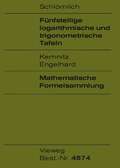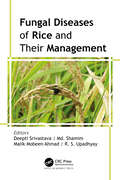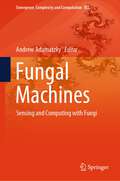- Table View
- List View
Fundamentals, Sensor Systems, Spectral Libraries, and Data Mining for Vegetation
by Prasad S. Thenkabail John G. Lyon Alfredo HueteWritten by leading global experts, including pioneers in the field, the four-volume set on Hyperspectral Remote Sensing of Vegetation, Second Edition, reviews existing state-of-the-art knowledge, highlights advances made in different areas, and provides guidance for the appropriate use of hyperspectral data in the study and management of agricultural crops and natural vegetation. Volume I, Fundamentals, Sensor Systems, Spectral Libraries, and Data Mining for Vegetation introduces the fundamentals of hyperspectral or imaging spectroscopy data, including hyperspectral data processes, sensor systems, spectral libraries, and data mining and analysis, covering both the strengths and limitations of these topics. This book also presents and discusses hyperspectral narrowband data acquired in numerous unique spectral bands in the entire length of the spectrum from various ground-based, airborne, and spaceborne platforms. The concluding chapter provides readers with useful guidance on the highlights and essence of Volume I through the editors’ perspective. Key Features of Volume I: Provides the fundamentals of hyperspectral remote sensing used in agricultural crops and vegetation studies. Discusses the latest advances in hyperspectral remote sensing of ecosystems and croplands. Develops online hyperspectral libraries, proximal sensing and phenotyping for understanding, modeling, mapping, and monitoring crop and vegetation traits. Implements reflectance spectroscopy of soils and vegetation. Enumerates hyperspectral data mining and data processing methods, approaches, and machine learning algorithms. Explores methods and approaches for data mining and overcoming data redundancy; Highlights the advanced methods for hyperspectral data processing steps by developing or implementing appropriate algorithms and coding the same for processing on a cloud computing platform like the Google Earth Engine. Integrates hyperspectral with other data, such as the LiDAR data, in the study of vegetation. Includes best global expertise on hyperspectral remote sensing of agriculture, crop water use, plant species detection, crop productivity and water productivity mapping, and modeling.
Funded!: Successful Grantwriting for Your Nonprofit
by Richard HoeferFunded! leads readers from knowing nothing about writing grants to having a complete grant proposal. Based on personal experience and the experiences of dozens of professional nonprofit grantwriters, students learn about writing grants by completing exercises at the end of each chapter, moving from finding funding opportunities to submitting the completed proposal. The book covers every essential grantwriting topic: finding funding, writing needs statements, finding or developing evidence-based programs, developing logic models, writing evaluation plans, describing implantation plans, budgeting, sustainability planning, and submission to the funder. Overall, it is an invaluable resource that provides flexibility for instructors, students, and professionals to learn about grantwriting in a variety of settings and formats.
Funded!: Successful Grantwriting for Your Nonprofit
by Richard HoeferFunded! leads readers from knowing nothing about writing grants to having a complete grant proposal. Based on personal experience and the experiences of dozens of professional nonprofit grantwriters, students learn about writing grants by completing exercises at the end of each chapter, moving from finding funding opportunities to submitting the completed proposal. The book covers every essential grantwriting topic: finding funding, writing needs statements, finding or developing evidence-based programs, developing logic models, writing evaluation plans, describing implantation plans, budgeting, sustainability planning, and submission to the funder. Overall, it is an invaluable resource that provides flexibility for instructors, students, and professionals to learn about grantwriting in a variety of settings and formats.
Funding and Financing Transport Infrastructure: Business Models to Enhance and Enable Financing of Infrastructure in Transport (Spon Research)
by Athena Roumboutsos Hans Voordijk Aristeidis PanteliasThis book seeks to enhance understanding of the impacts of project setup and its implementation environment on project performance by leveraging information from the study of a rich set of European transport infrastructure project cases. It puts forward a system’s view of project delivery and aims to serve as a strategic tool for decision makers and practitioners. The proposed approach is not limited to specific stakeholder views. On the contrary, it allows stakeholders to formulate their own strategies based on an holistic set of potential implementation scenarios. Furthermore, by including cases of projects that have been influenced by the recent financial crisis, the book aims to capitalise on experiences and provide guidelines as to the design and implementation of resilient projects delivered both through traditional as well as Public Private Partnership (PPP) models. Finally, the book proposes a new Transport Infrastructure Resilience Indicator and a corresponding project rating system that can be assessed with an eye to the future, ultimately aiming to support the successful delivery of transport infrastructure projects for all stakeholders involved.
Funding and Financing Transport Infrastructure: Business Models to Enhance and Enable Financing of Infrastructure in Transport (Spon Research)
by Athena Roumboutsos Hans Voordijk Aristeidis PanteliasThis book seeks to enhance understanding of the impacts of project setup and its implementation environment on project performance by leveraging information from the study of a rich set of European transport infrastructure project cases. It puts forward a system’s view of project delivery and aims to serve as a strategic tool for decision makers and practitioners. The proposed approach is not limited to specific stakeholder views. On the contrary, it allows stakeholders to formulate their own strategies based on an holistic set of potential implementation scenarios. Furthermore, by including cases of projects that have been influenced by the recent financial crisis, the book aims to capitalise on experiences and provide guidelines as to the design and implementation of resilient projects delivered both through traditional as well as Public Private Partnership (PPP) models. Finally, the book proposes a new Transport Infrastructure Resilience Indicator and a corresponding project rating system that can be assessed with an eye to the future, ultimately aiming to support the successful delivery of transport infrastructure projects for all stakeholders involved.
Funds, Flows and Time: An Alternative Approach to the Microeconomic Analysis of Productive Activities
by Pere Mir-Artigues Josep Gonzalez-CalvetThis book sheds new light on long-established concepts of microeconomic production theory and combines general theoretical analysis with references to management tools. It deals with concepts of microeconomic production theory, using the fund-flow model of Nicholas Georgescu-Roegen as a basic reference. This long-neglected model allows for a representation of productive operations that can easily be accommodated to empirical application.
Fünf Jahrtausende Radfahrzeuge: 2 Jahrhunderte Straßenverkehr mit Wärmeenergie. Über 100 Jahre Automobile
by Rudolf KrebsVom Ochsenkarren der Urzeit bis zum PKW des 21. Jahrhunderts wird die Entwicklungsgeschichte der Radfahrzeuge spannend und mit technikhistorischer Genauigkeit beschrieben.
Fünfachsiges NC-Fräsen: Beitrag zur Technologie, Teileprogrammierung und Postprozessorverarbeitung (ISW Forschung und Praxis #14)
by H. DamsohnFünfachsiges NC-Fräsen gekrümmter Flächen: Beitrag zur numerischen Flächendarstellung, Programmierung und Fertigung (ISW Forschung und Praxis #16)
by H. HenningFünfachsiges NC-Umfangsfräsen verwundener Regelflächen: Beitrag zur Technologie und Teileprogrammierung (ISW Forschung und Praxis #33)
by W. SielaffFünfstellige logarithmische und trigonometrische Tafeln
by Oskar Schlömilch Friedrich Kemnitz Rainer EngelhardFünfstellige Tabellen zu den Elliptischen Funktionen / Five Place Tables of Elliptical Functions: Dargestellt Mittels des Jacobischen Parameters q / Based on Jacobi’s Parameter q
by Max Schuler Hans GebeleinFungal Biopolymers and Biocomposites: Prospects and Avenues
by Sunil K. Deshmukh Mukund V. Deshpande Kandikere R. SridharThe book covers an overview of fungal polymers, fungal mycelial biomass, and their applications besides providing a detailed account of various opportunities. This book also includes information on developments in mycotechnology related to fashion, furnishing, construction, packaging, mycelial-based bricks, construction binder, cementing materials, and so on. Other aspects include the value of chitin, chitosan, hydrophobins, lignocellulosic composites, oil recovery, biosurfactants and bioemulsifiers, nanofibers from pullulan, exopolymeric substances, bioresins, and biocomposites. Additional topics covered in the book include self-healing fungal concrete (which could help to build repairs) and recipe to inhibit fruit body formation, for living fungal biomaterial manufacture. There is no comprehensive book other than – some reviews, which addressed very brief historical developments and preliminary aspects of fungal biopolymers. Written by experts in their field from countries like Australia, India, USA, Germany, Turkey, Philippines, Oman, Belgium, Italy, Egypt, Brazil, and the United Kingdom, the chapters discuss at length applications of filamentous fungi in sustainable industrial pursuits and industrial developments with environmental safety. This book will be useful for students, teachers, researchers, and scientists in botany, microbiology, life sciences, biotechnology, agriculture and, industries that extensively use fungi for the production of value-added products.
Fungal Cellulolytic Enzymes: Microbial Production and Application
by Xu Fang Yinbo QuThe book provides an overview of the current knowledge on cellulolytic enzymes and their applications. It summarizes the mechanisms of synthesis and hydrolysis of cellulolytic enzymes, industrial fungal strains, genetic engineering of fungal strains and application of cellulolytic enzymes. This book will be a useful reference for researchers and bioengineering experts engaged in lignocelluloses biodegradation, biomass utilization, enzyme production and fungal molecular biology.
Fungal Diseases of Rice and Their Management
by Deepti Srivastava Md. Shamim Malik Mobeen Ahmad R. S. UpadhyayRice is a widely consumed crop around the world that has tremendous importance and is cultivated almost everywhere except Antarctica. However, various biotic and abiotic stresses have a negative effect on rice cultivation, seriously reducing its yield. This volume examines the bacterial and fungal pathogens that cause rice diseases and explores how to manage these diseases. It covers the economic and environmental impact of rice fungal diseases on global food security and proceeds to delve into diagnostic methods for rice fungal pathogen detection and discusses current strategic and applied biotechnological methods for the effective management of rice fungal diseases.
Fungal Diseases of Rice and Their Management
Rice is a widely consumed crop around the world that has tremendous importance and is cultivated almost everywhere except Antarctica. However, various biotic and abiotic stresses have a negative effect on rice cultivation, seriously reducing its yield. This volume examines the bacterial and fungal pathogens that cause rice diseases and explores how to manage these diseases. It covers the economic and environmental impact of rice fungal diseases on global food security and proceeds to delve into diagnostic methods for rice fungal pathogen detection and discusses current strategic and applied biotechnological methods for the effective management of rice fungal diseases.
Fungal Machines: Sensing and Computing with Fungi (Emergence, Complexity and Computation #47)
by Andrew AdamatzkyThis unique book explores fungi as sensors, electronic devices, and potential future computers, offering eco-friendly alternatives to traditional electronics. Fungi are ancient, widely distributed organisms ranging from microscopic single cells to massive mycelium spanning hectares. They possess senses similar to humans, detecting light, chemicals, gases, gravity, and electric fields. It covers fungal electrical activity, sensors, electronics, computing prototypes, and fungal language. Authored by leading experts from diverse fields, the book is accessible to readers of all backgrounds, from high-schoolers to professors. It reveals the remarkable potential of fungal machines while minimizing environmental impact.
Fungal Nanobionics: Principles and Applications
by Ram Prasad Vivek Kumar Manoj Kumar Shanquan WangFungal nanobionics has great prospects for developing new products with industrial, agriculture, medicine and consumer applications in a wide range of sectors. The fields of chemical engineering, agri-food, biochemical, pharmaceuticals, diagnostics and medical device development all employ fungal products, with fungal nanomaterials currently used in a wide range of applications, ranging from drug development to food industry and agricultural sector. The fungal agents emerge as an environmentally friendly, clean, non‐toxic agent for the biogenic metal nanoparticles and employs both intracellular and extracellular methods. The simplicity of scaling up and downstream processing and the presence of fungal mycelia affording an increased surface area provide key advantages. In addition, the larger spectrum of synthesized nanoparticle morphologies and the substantially faster biosynthesis rate in cell-free filtrate (due to the higher amount of proteins secreted in fungi) make this a particularly enticing route. Understanding the diversity of fungi in assorted ecosystems, as well as their interactions with other microorganisms, animals and plants, is essential to underpin real and innovative technological developments and the applications of metal nanoparticles in many disciplines including agriculture, catalysis, and biomedical biosensors. Importantly, biogenic fungal nanoparticles show significant synergistic characteristics when combined with antibiotics and fungicides to offer substantially greater resistance to microbial growth and applications in nanomedicine ranging from topical ointments and bandages for wound healing to coated stents.
Fungal Nanotechnology: Applications in Agriculture, Industry, and Medicine (Fungal Biology)
by Ram PrasadFungal nanotechnology has great prospects for developing new products with industrial, agricultural, medicinal, and consumer applications in a wide range of sectors. The fields of chemical engineering, agri-food, biochemistry, pharmaceuticals, diagnostics, and medical device development all employ fungal products, with fungal nanomaterials currently used in applications ranging from drug development to the food industry and agricultural biotechnology. Fungal agents are an environmentally friendly, clean, non‐toxic agent for the synthesis of metal nanoparticles and employ both intracellular and extracellular methods. The simplicity of scaling up and downstream processing and the presence of fungal mycelia which afford an increased surface area provide key advantages. In addition, the large spectrum of synthesized nanoparticle morphologies and the substantially faster biosynthesis rate in cell-free filtrate (due to the higher amount of proteins secreted in fungi) make this a particularly enticing route. Understanding the diversity of fungi in assorted ecosystems, as well as their interactions with other microorganisms, animals, and plants, underpins real and innovative technological developments and the applications of metal nanoparticles in many disciplines including agriculture, catalysis, and biomedical biosensors. Importantly, biogenic fungal nanoparticles show significant synergistic characteristics when combined with antibiotics and fungicides to offer substantially greater resistance to microbial growth and applications in nanomedicine ranging from topical ointments and bandages for wound healing to coated stents.
Fungal Pathogenesis in Plants and Crops: Molecular Biology and Host Defense Mechanisms, Second Edition
by P. VidhyasekaranDramatic progress in molecular biology and genetic engineering has recently produced an unparalleled wealth of information on the mechanisms of plant and pathogen interactions at the cellular and molecular levels. Completely revised and expanded, Fungal Pathogenesis in Plants and Crops: Molecular Biology and Host Defense Mechanisms, Second Edition
Fungal Plant Pathogens: Applied Techniques
by Kinda Alraiss Rachel Barker Victoria Barton Lucy Carson-Taylor David Cooke Ashleigh Elliot David Galsworthy Steve Hendry Anthony Kermode Paul Kirk Michael Long Aiga Ozolina Ana Pérez-Sierra Belinda Phillipson Matthew J Ryan David Smith Christopher Thornton Jenny Tomlinson Joan WebberThis substantially updated edition now in full colour provides key techniques used when working with fungal and fungal-like plant pathogens. As a practical manual it also deals with disease recognition, detection and identification of fungi, plus methods to characterise and curate fungi and handle them under quarantine and quality assurance systems. Furthermore, this new edition includes significant updates with respect to: - Greater awareness and concern internationally about plant health and biosecurity. - Molecular biology - next generation sequencing and in-field detection. - Improved opportunities for surveillance and detection in diverse substrates. - Changes in taxonomy and reference to current fungal plant pathogens. - New chapters on tree health, and public awareness, outreach and communications. Fungal Plant Pathogens: Applied Techniques, 2nd edition provides a valuable guide to investigating fungal plant diseases and interpreting laboratory findings for postgraduate and advanced undergraduate students, extension plant pathologists, consultants and advisers in agriculture, forestry and horticulture, and the food supply chain.
Fungi: Applications and Management Strategies (Progress in Mycological Research #3)
by S. K. Deshmukh J. K. Misra J. P. Tewari Tamás PappThe book deals with the application of fungi and the strategic management of some plant pathogens. It covers fungal bioactive metabolites, with emphasis on those secondary metabolites that are produced by various endophytes, their pharmaceutical and agricultural uses, regulation of the metabolites, mycotoxins, nutritional value of mushrooms, prospecting of thermophilic and wood-rotting fungi, and fungi as myconano factories. Strategies for the management of some plant pathogenic fungi of rice and soybean have also been dealt with. Updated information for all these aspects has been presented and discussed in different chapters.
Fungi: Applications and Management Strategies (Progress in Mycological Research)
by Sunil K. Deshmukh J. K. Misra Jalpa P. Tewari Tamas PappThe book deals with the application of fungi and the strategic management of some plant pathogens. It covers fungal bioactive metabolites, with emphasis on those secondary metabolites that are produced by various endophytes, their pharmaceutical and agricultural uses, regulation of the metabolites, mycotoxins, nutritional value of mushrooms, prospecting of thermophilic and wood-rotting fungi, and fungi as myconano factories. Strategies for the management of some plant pathogenic fungi of rice and soybean have also been dealt with. Updated information for all these aspects has been presented and discussed in different chapters.
Fungi and Food Spoilage
by John I. Pitt A.D. HockingThis book is designed as a laboratory guide for the food microbiologist, to assist in the isolation and identification of common food-borne fungi. We emphasise the fungi which cause food spoilage, but also devote space to the fungi commonly encountered in foods at harvest, and in the food factory. As far as possible, we have kept the text simple, although the need for clarity in the descriptions has necessitated the use of some specialised mycological terms. The identification keys have been designed for use by microbiologists with little or no prior knowledge of mycology. For identification to genus level, they are based primarily on the cultural and physiological characteristics of fungi grown under a standardised set of conditions. The microscopic features of the various fungi become more important when identifying isolates at the species level. Nearly all of the species treated have been illustrated with colony photographs, together with photomicrographs or line drawings. The photomicrographs were taken using a Zeiss WL microscope fitted with Nomarski interference contrast optics. We are indebted to Mr W. Rushton and Ms L. Burton, who printed the many hundreds of photographs used to make up the figures in this book. We also wish to express out appreciation to Dr D.L. Hawksworth, Dr A.H.S.




















